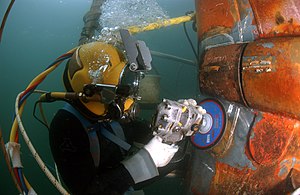
Back غوص احترافي Arabic Erhvervsdykning Danish Berufstauchen German Επαγγελματική κατάδυση Greek Buceo profesional Spanish غواصی صنعتی Persian Ջրասուզական աշխատանքներ Armenian Immersione professionale Italian Selam profesional Malay Scufundare profesională Romanian

Professional diving is underwater diving where the divers are paid for their work. Occupational diving has a similar meaning and applications. The procedures are often regulated by legislation and codes of practice as it is an inherently hazardous occupation and the diver works as a member of a team. Due to the dangerous nature of some professional diving operations, specialized equipment such as an on-site hyperbaric chamber and diver-to-surface communication system is often required by law, and the mode of diving for some applications may be regulated.
There are several branches of professional diving, the best known of which is probably commercial diving and its specialised applications, offshore diving, inshore civil engineering diving, marine salvage diving, hazmat diving, and ships husbandry diving. There are also applications in scientific research, marine archaeology, fishing and aquaculture, public service, law enforcement, military service, media work and diver training.
Any person wishing to become a professional diver normally requires specific training that satisfies any regulatory agencies which have regional or national authority, such as US Occupational Safety and Health Administration, United Kingdom Health and Safety Executive or South African Department of Employment and Labour.[1][2] International recognition of professional diver qualifications and registration exists between some countries.
© MMXXIII Rich X Search. We shall prevail. All rights reserved. Rich X Search